| The
ATMs in Costa Rica (I). KLÜSSENDORF issue |
|
 |
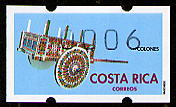 |
| Subject
: |
|
Typical
oxcart |
|
Date
of issue :
|
|
July
12, 1993 |
|
Size
:
|
|
43
x 25,5 mm. |
|
Paper
:
|
|
Phosphorescent.
Multicolour drawing |
|
Design
:
|
|
- |
|
Printer
:
|
|
Enschede,
Netherlands |
|
Printing
value :
|
|
Black |
|
Printing
:
|
|
2.000.000 |
|
| Click
on the image to enlarge |
On July 12th, 1993 the Correos
de Costa Rica installed in San Jose, country's
capital, 4 ATM vending machines from the German company Klüssendorf
- Model 631.
The
new distributors were installed in the Main Post Office,
Gran Hotel Costa Rica, Hotel
Alameda and Restaurant Soda Palace.
The vending machines used only one paper or design.
They worked with coins and it was possible to obtain 16 different
values programmed corresponding to the common franking
values or combinations at these date:
6, 9, 10, 13, 15, 23, 25, 28, 30, 35, 40, 45, 50, 60, 70 and
85 ¢ (colones).
The machines issued also a purchase receipt.
The collectors consider also "short" sets
with 4 basic values: 13, 15, 25 and 35 ¢.
The dates are not known in which the distributors were
out of service, possibly only worked during few months; the
equipment installed in the Main Post Office
was in discontinuous use until 1995. |
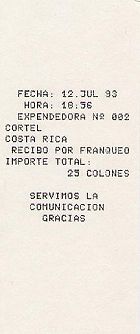 |
Receipt
of the First Day of issue for the
purchase of one ATM with value 25¢.
Size: 57 x 138 mm. |
The
characteristics of this ATMs are identical to others
of type Klüssendorf,
gummed papers including two semicircles
in the upper part and two more in the lower one.
Each 5 ATMs
appears a control number on the back that indicates the
number of stamps that still are in the machine. As the
coils are of 2000 labels, the first number obtained is the 2000
and last one 5. |
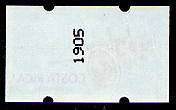 |
The
Philatelic Office of Correos de Costa
Rica prepared a collection
of 16 First Day Covers, with all the values issued by the vending
machines.
This collection was offered to all the customers through a
letter sent in August 23rd, 1993.
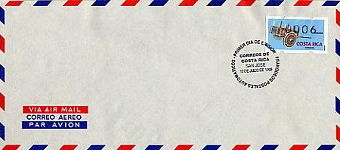 |
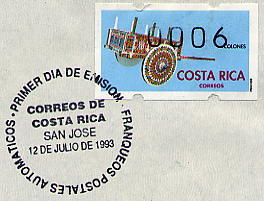 |
| One
of the covers (size: 24 x 10,5 cm.) of the official
collection and detail of the ATM with the commemorative
postmark of the First Day of Issue. |
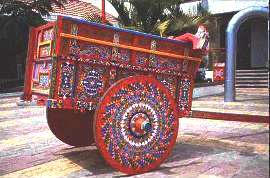 |
The
typical oxcart was used during the colonial age to transport
sugar cane and the tobacco and nowadays is still used by some
coffee growers to transport the coffee.
From old ages farmers used to paint the carts with attractive
and colourful motifs to preserve and made them beautiful. At first
the designs were simple, but later painting the carts turned
to a competition between the different properties and the owners
wanted to have the best pair of oxen and the most beautiful cart.
Nowadays is one of the more representative artisan objects of
the national culture.
The
typical oxcart was declared national symbol during
the President Oscar Arias Sanchez mandate, on March
22nd, 1988 and it represents a tribute to work and art. |
ATM
Web - Spain and Latin American Postal Services: http://www.ateeme.net
© J. Jove - M. Sans. ATEEME.
Variable value stamps study group.
Reproduction is prohibited. All rights reserved
This page was created in 2000 and last updated:
01.04.11
|






